Scientific name Cryptocoryne Rank Genus | Tribe Cryptocoryneae Higher classification Arum | |
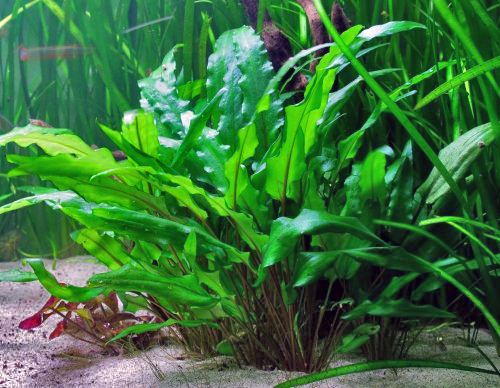 | ||
Lower classifications Cryptocoryne wendtii, Cryptocoryne beckettii, Cryptocoryne affinis, Cryptocoryne aponogetifolia, Cryptocoryne pontederiifolia | ||
Preparing a cryptocoryne for planting in an aquarium
Cryptocoryne (water trumpet) is a genus of aquatic monocot plants from the family Araceae (arums). The genus is naturally distributed in tropical regions of Asia and New Guinea.
Contents
- Preparing a cryptocoryne for planting in an aquarium
- Jacob s plant guide cryptocoryne
- Cultivation and uses
- Crypt melt
- References
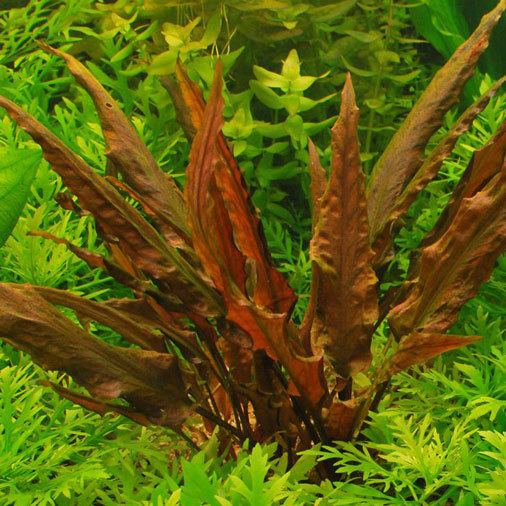
The typical habitats of Cryptocoryne are mostly streams and rivers with not too rapidly flowing water, in the lowland forest. They also live in seasonally inundated forest pools or on river banks submerged only at high water. Although the proper scientific name of the genus is Cryptocoryne, they are commonly referred to as crypts. The English name "water trumpet" refers to their inflorescence, a spadix enclosed by a spathe (typical for the whole family), which resembles a trumpet.
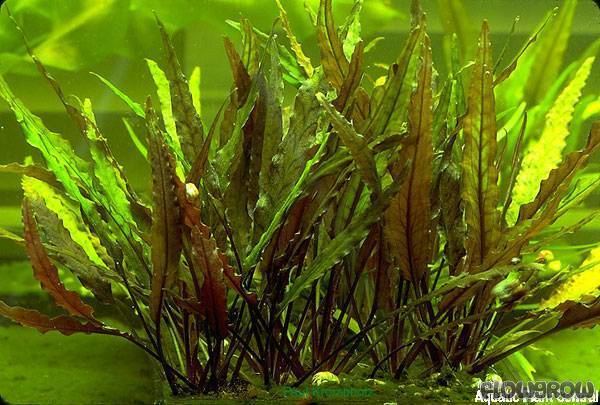
The first Cryptocoryne species was described in 1779 as Arum spirale by Retzius. The genus was described by Friedrich Ernst Ludwig von Fischer in 1828. However, the scientific classification of Cryptocoryne species is very complicated and there are different opinions about it. Lagenandra is another genus closely related to the genus Cryptocoryne. The two can be easily told apart since the leaves of Cryptocoryne species exhibit convolute vernation whereas Lagenandra species exhibit involute vernation.
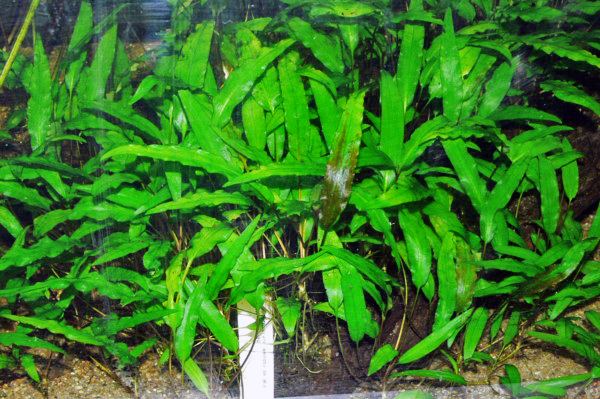
The name Cryptocoryne is derived from the Greek crypto, hidden, and koryne, meaning club. The common name (water trumpet) refers to the shape of its inflorescence, which is typical of the arum family.
- Cryptocoryne affinis N.E.Br. in J.D.Hooker - Thailand, Malaysia
- Cryptocoryne alba de Wit - Sri Lanka
- Cryptocoryne albida R.Parker - southern China, eastern India, Bangladesh, Indochina
- Cryptocoryne annamica Serebryanyi - Vietnam
- Cryptocoryne aponogetifolia Merr. - Philippines
- Cryptocoryne aura - West kalimantan
- Cryptocoryne auriculata Engl. - Sarawak, Palawan, Mindanao
- Cryptocoryne bangkaensis Bastm. - Sumatra
- Cryptocoryne beckettii Thuill. ex Trim. - Sri Lanka; naturalized in Texas
- Cryptocoryne bogneri Rataj - Sri Lanka
- Cryptocoryne bullosa Becc. - Sarawak
- Cryptocoryne ciliata (Roxb.) Schott - India, Bangladesh, Indochina, Malaysia, Indonesia, New Guinea
- Cryptocoryne cognata Schott - India
- Cryptocoryne consobrina Schott - India
- Cryptocoryne cordata Griff. - Thailand, Malaysia, Borneo, Java
- Cryptocoryne coronata Bastm. & Wijng. - Philippines
- Cryptocoryne crispatula Engl. southern China, northeastern India, Bangladesh
- Cryptocoryne cruddasiana Prain - Myanmar
- Cryptocoryne decus-silvae de Wit - Malaysia
- Cryptocoryne dewitii'' N.Jacobsen - Papua New Guinea
- Cryptocoryne edithiae de Wit - Kalimantan
- Cryptocoryne elliptica N.E.Br. - Malaysia
- Cryptocoryne ferruginea Engl. - Sarawak
- Cryptocoryne fusca de Wit - Borneo
- Cryptocoryne griffithii Schott - Kalimantan, Peninsular Malaysia
- Cryptocoryne hudoroi Bogner & N.Jacobsen - Kalimantan
- Cryptocoryne ideii Budianto - Kalimantan
- Cryptocoryne jacobsenii de Wit - Sumatra
- Cryptocoryne keei N.Jacobsen - Sarawak
- Cryptocoryne lingua Becc. ex Engl - Sarawak
- Cryptocoryne loeiensis Bastm., T.Idei & N.Jacobsen - Laos, Thailand
- Cryptocoryne longicaudaBecc. ex Engl. - Borneo, Malaysia, Sumatra
- Cryptocoryne mekongensis T.Idei, Bastm. & N.Jacobsen - Laos, Thailand
- Cryptocoryne minima Ridl. - Malaysia, Sumatra
- Cryptocoryne moehlmannii de Wit - Sumatra
- Cryptocoryne nevillii Trimen - Sri Lanka
- Cryptocoryne noritoi Wongso - Kalimantan
- Cryptocoryne nurii Furtado - Peninsular Malaysia
- Cryptocoryne pallidinervia Engl. - Borneo
- Cryptocoryne parva de Wit- Sri Lanka
- Cryptocoryne pontederiifolia Schott - Sumatra
- Cryptocoryne purpurea Ridl. - Peninsular Malaysia, Borneo
- Cryptocoryne pygmaea Merr. - Philippines
- Cryptocoryne retrospiralis (Roxb.) Kunth - Bangladesh, India, Myanmar
- Cryptocoryne schulzei de Wit - Johor
- Cryptocoryne scurrilis de Wit - Sumatra
- Cryptocoryne sivadasanii Bogner - southern India
- Cryptocoryne spiralis (Retz.) Fisch. ex Wydler - Bangladesh, India
- Cryptocoryne striolata Engl. - Borneo
- Cryptocoryne tambraparaniana Rajakumar, P.Daniel, Selvak., S.Murug. & Chellap. - Tamil Nadu
- Cryptocoryne thwaitesii Schott - Sri Lanka
- Cryptocoryne × timahensis Bastm. - Singapore (C. cordata × C. nurii)
- Cryptocoryne uenoi Yuji Sasaki - Sarawak
- Cryptocoryne undulata Wendt - Sri Lanka
- Cryptocoryne usteriana Engl. - Philippines
- Cryptocoryne versteegii Engl. - New Guinea
- Cryptocoryne vietnamensis I.Hertel & H.Mühlberg - Vietnam
- Cryptocoryne villosa N.Jacobsen - Sumatra
- Cryptocoryne walkeri Schott - Sri Lanka
- Cryptocoryne wendtii de Wit - Sri Lanka
- Cryptocoryne x willisii Reitz - Sri Lanka (C. parva × C. walkeri)
- Cryptocoryne yujii Bastm. - Sarawak
- Cryptocoryne zaidiana Ipor & Tawan - Sarawak
- Cryptocoryne zukalii Rataj - Peninsular Malaysia
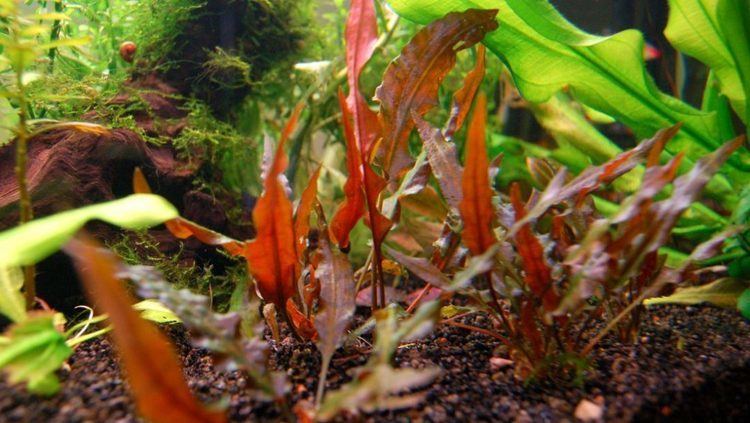
Jacob s plant guide cryptocoryne
Cultivation and uses
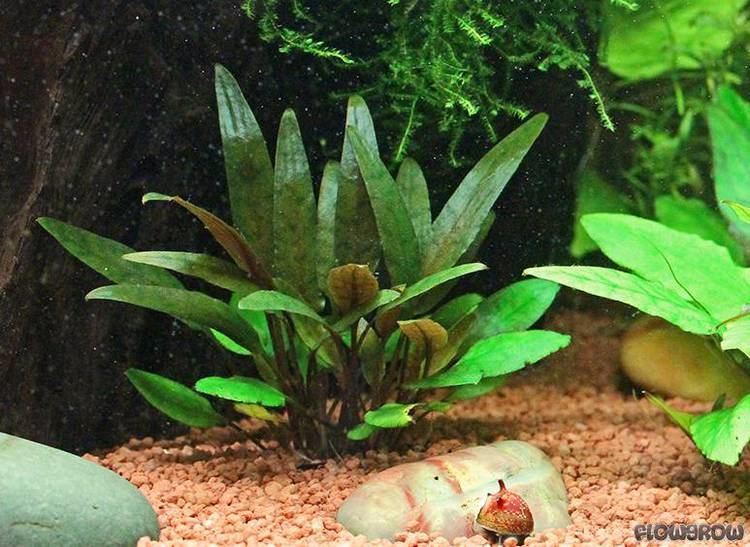
Some water trumpets are popular commercially cultivated aquarium plants. Submerged plants reproduce vegetatively, emerse plants may flower and reproduce sexually. Many species are cultivated only by dedicated experts and are very hard to grow, or are not present in a culture at all. Some species are endangered because their natural habitats are disappearing. On the other hand, some water trumpets (e.g. Cryptocoryne beckettii) are very hardy aquarium plants, easy to grow to the point that they have become an invasive species after being introduced in Florida in North America.
Some of the Cryptocorynes are generally the easier ones to keep (in fact, some species, such as Cryptocoryne wendtii are said to be among the most versatile of aquarium plants); they require low to moderate light (but can grow faster in more intense light), a temperature range of around 20 to 33 °C, and slightly acidic or neutral pH, though they can adapt to higher pH as well. In contrast to accepted aquarium wisdom, it thrives well in calcareous water. Many modern aquariums may be too well lit for crypts to thrive.
Plants of the genus Cryptocoryne, which range from India to New Guinea are found in very diverse conditions. Some are true acid loving plants such as C. grabowski, found in peat bogs in Borneo, while others such as C. balansae and C. pontiderifolia are found in streams with limestone beds—hard alkaline water. One species, C. ciliata is even found in semi brackish water in some areas. It is one of the few aquarium plants that tolerates salt concentrations that would almost certainly kill other aquarium plants.
There has been an extensive revision of the genus by Jacobsen and many names aquarists are familiar with have been changed. Crypts also have an annoying (to taxonomists!) tendency to hybridize freely in nature and there are a handful of "species" found in nature that are hybrids. Together with the fact that some species show a large variability (C. wendtii) and can only be properly identified by the flowering spathe, this makes it difficult to identify some species solely on leaf habit.
Cryptocoryne plants have been in cultivation in the aquarium hobby since the late 18th century, although it was not until the 1960s that more than a handful of species was known and became more common in the hobby. New species still regularly crop up as interest in these plants widens and more collecting expeditions by private parties are carried out.
Crypts are of commercial importance in the pet trade and have escaped into the wild in America, Jamaica, and other places. Texas and Florida both have stands of well established populations and these are considered invasive weeds with no known methods of control.
Crypt melt
A phenomenon often encountered when planting new crypts in an aquarium is commonly called Crypt melt, whereby the plant loses all its leaves. There seem to be two possible causes for this.
Rapid environmental changes is thought to trigger this, as these plants don't seem to adapt well to transplantion, and may need 30 days or so to become established and for the leaves to regrow. Experienced growers report that it is better to plant crypts in aquariums that have been established for at least three months.
In the wild, Crypts can grow fully submerged underwater, but in Oriental nurseries they are often grown emersed and crypt melt could then be triggered by the change from emerse to submerse conditions.
There is lately a trend for such nurseries to send crypts as just a rootstock (i.e. without the leaves) to reduce shipping costs and because the leaves will be lost anyway once planted in an aquarium.
Other reports emphasise the need to change the aquarium water regularly to prevent the buildup of nitrates which are thought to trigger this condition (often referred to as a disease)
